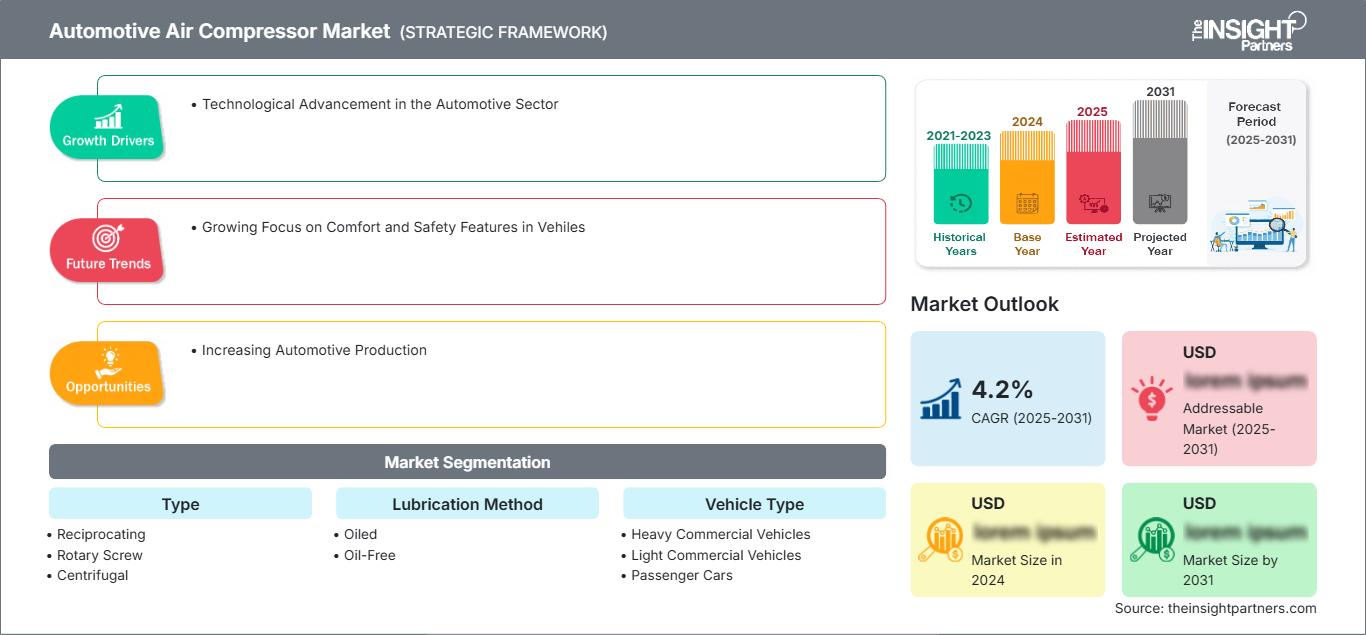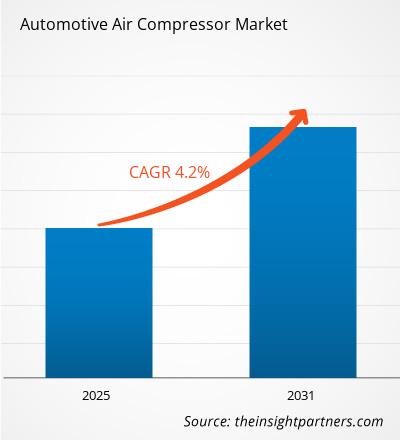Der Markt für Kfz-Luftkompressoren wird zwischen 2023 und 2031 voraussichtlich eine durchschnittliche jährliche Wachstumsrate (CAGR) von 4,2 % verzeichnen. Die Entwicklung fortschrittlicher Technologien in Fahrzeugen wird voraussichtlich ein wichtiger Markttrend bleiben.
Marktanalyse für Kfz-Luftkompressoren
- Der Absatz von Kfz-Luftkompressoren dürfte aufgrund einer Reihe von Faktoren anziehen, darunter eine Zunahme der Fahrzeugbesitzzahlen, ein steigendes Verbraucherbedürfnis nach Komfort in ihren Fahrzeugen und eine Zunahme der Anzahl von Straßenfahrzeugen.
- Die Integrität und Qualität der Produkte sowie die Aufrechterhaltung der Betriebseffizienz hängen von der Qualität der Druckluftfahrzeuge ab. Diese Faktoren treiben auch das Marktwachstum von Kfz-Luftkompressoren voran.
Marktübersicht für Kfz-Luftkompressoren
- Der Verdampfer eines Autos wird mithilfe einer Klimaanlage entfernt, um das wärmeerzeugende Kältemitteldampf zu extrahieren. Aufgrund der wachsenden Fahrzeugproduktion und der zunehmenden Installation hochwertiger Komfortausstattungen in preisgünstigen Fahrzeugen wird für den Markt in den kommenden Jahren ein deutliches Wachstum prognostiziert.
- Der Markt für Kfz-Luftkompressoren wird ebenfalls aufgrund der steigenden Automobilproduktion und der zunehmenden Nutzung von Autoklimaanlagen in Schwellenländern wachsen. Da der Betrieb von Kompressoren auf Kältemittel angewiesen ist, haben Regierungen weltweit Gesetze erlassen, um die durch diese Gase verursachte Umweltverschmutzung zu reduzieren.
- Es wird erwartet, dass die strikte Einhaltung dieser Vorschriften das Wachstum des Kfz-Klimaanlagensektors hemmen wird. Darüber hinaus haben Leistungs- und Effizienzverbesserungen von Kfz-Luftkompressoren Klimaanlagen in letzter Zeit erschwinglicher gemacht, was das Marktwachstum vorantreibt.
Passen Sie diesen Bericht Ihren Anforderungen an
Sie erhalten kostenlos Anpassungen an jedem Bericht, einschließlich Teilen dieses Berichts oder einer Analyse auf Länderebene, eines Excel-Datenpakets sowie tolle Angebote und Rabatte für Start-ups und Universitäten.
Markt für Automobil-Luftkompressoren: Strategische Einblicke

- Holen Sie sich die wichtigsten Markttrends aus diesem Bericht.Dieses KOSTENLOSE Beispiel umfasst Datenanalysen, die von Markttrends bis hin zu Schätzungen und Prognosen reichen.
Sie erhalten kostenlos Anpassungen an jedem Bericht, einschließlich Teilen dieses Berichts oder einer Analyse auf Länderebene, eines Excel-Datenpakets sowie tolle Angebote und Rabatte für Start-ups und Universitäten.
Markt für Automobil-Luftkompressoren: Strategische Einblicke

- Holen Sie sich die wichtigsten Markttrends aus diesem Bericht.Dieses KOSTENLOSE Beispiel umfasst Datenanalysen, die von Markttrends bis hin zu Schätzungen und Prognosen reichen.
Markttreiber und -chancen für Luftkompressoren in der Automobilindustrie
Technologischer Fortschritt in der Automobilindustrie begünstigt den Markt
- Entwicklungen im Design und in der Technologie von Luftkompressoren haben auch die Entwicklung des Marktes für Luftkompressoren in der Automobilindustrie beschleunigt.
- Die Erstausrüster experimentieren mit der Konstruktion leichter, effizienterer und kompakterer Autokühlsysteme, um so Größe und Abmessungen moderner Autoklimaanlagen zu reduzieren.
- Darüber hinaus hat die Innovation in der Entwicklung von Kompressoren für Autoklimaanlagen dazu beigetragen, die Fahrzeugkühlung zu verbessern und gleichzeitig die Fahrzeugvibration zu reduzieren.
Wachsender Fokus auf autonome und elektrische Fahrzeuge
- Die Automobilindustrie steht vor großen Veränderungen und Entwicklungen, um die Produktion zu steigern und die neuen Anforderungen der Verbraucher zu erfüllen.
- Der wachsende technologische Fortschritt und der zunehmende Fokus der Verbraucher auf Luxus und Sicherheitsmerkmale steigern den Verkauf von Premiumautos, was auch neue Möglichkeiten für die Markt.
Segmentierungsanalyse des Marktberichts für Luftkompressoren für Kraftfahrzeuge
Schlüsselsegmente, die zur Ableitung der Marktanalyse für Luftkompressoren für Kraftfahrzeuge beigetragen haben, sind Typ, Schmiermethode und Fahrzeugtyp.
- Basierend auf dem Typ ist der Markt für Luftkompressoren für Kraftfahrzeuge in Kolben-, Schrauben- und Kreiselkompressoren unterteilt.
- Auf der Grundlage der Schmiermethode ist der Markt in geölt und ölfrei unterteilt.
- Basierend auf dem Fahrzeugtyp ist der Markt für Luftkompressoren für Kraftfahrzeuge in schwere Nutzfahrzeuge, leichte Nutzfahrzeuge und Personenkraftwagen unterteilt.
Marktanteilsanalyse für Luftkompressoren für Kraftfahrzeuge nach Geografie
- Der Marktbericht für Luftkompressoren für Kraftfahrzeuge umfasst eine detaillierte Analyse von fünf großen geografischen Regionen, einschließlich der aktuellen und historischen Marktgröße und Prognosen für 2021 bis 2031, die Nordamerika, Europa, Asien-Pazifik (APAC), Naher Osten und Afrika (MEA) sowie Süd- und Südamerika abdecken. Mittelamerika.
- Jede Region ist weiter in entsprechende Länder unterteilt. Dieser Bericht bietet Analysen und Prognosen für über 18 Länder und deckt die Marktdynamik von Kfz-Luftkompressoren ab, wie z. B. Treiber, Trends und Chancen, die die Märkte auf regionaler Ebene beeinflussen.
- Der Bericht umfasst außerdem eine PEST-Analyse, die die Untersuchung der wichtigsten Faktoren umfasst, die den Markt für Kfz-Luftkompressoren in diesen Regionen beeinflussen.
Regionale Einblicke in den Markt für Kfz-Luftkompressoren
Die Analysten von The Insight Partners haben die regionalen Trends und Faktoren, die den Markt für Kfz-Luftkompressoren im Prognosezeitraum beeinflussen, ausführlich erläutert. In diesem Abschnitt werden auch die Marktsegmente und die geografische Lage in Nordamerika, Europa, im asiatisch-pazifischen Raum, im Nahen Osten und Afrika sowie in Süd- und Mittelamerika erörtert.
Umfang des Marktberichts über Luftkompressoren für Kraftfahrzeuge
| Berichtsattribut | Einzelheiten |
|---|---|
| Marktgröße in 2024 | US$ XX million |
| Marktgröße nach 2031 | US$ XX Million |
| Globale CAGR (2025 - 2031) | 4.2% |
| Historische Daten | 2021-2023 |
| Prognosezeitraum | 2025-2031 |
| Abgedeckte Segmente |
By Typ
|
| Abgedeckte Regionen und Länder | Nordamerika
|
| Marktführer und wichtige Unternehmensprofile |
|
Dichte der Marktteilnehmer für Luftkompressoren für Kraftfahrzeuge: Auswirkungen auf die Geschäftsdynamik verstehen
Der Markt für Kfz-Luftkompressoren wächst rasant. Die steigende Nachfrage der Endverbraucher ist auf Faktoren wie veränderte Verbraucherpräferenzen, technologische Fortschritte und ein stärkeres Bewusstsein für die Produktvorteile zurückzuführen. Mit der steigenden Nachfrage erweitern Unternehmen ihr Angebot, entwickeln Innovationen, um den Bedürfnissen der Verbraucher gerecht zu werden, und nutzen neue Trends, was das Marktwachstum weiter ankurbelt.

- Holen Sie sich die Markt für Automobil-Luftkompressoren Übersicht der wichtigsten Akteure
Marktnachrichten und aktuelle Entwicklungen zu Luftkompressoren für Kraftfahrzeuge
Der Markt für Luftkompressoren für Kraftfahrzeuge wird anhand qualitativer und quantitativer Daten aus Primär- und Sekundärforschung bewertet, die wichtige Unternehmenspublikationen, Verbandsdaten und Datenbanken einbeziehen. Nachfolgend sind einige Entwicklungen auf dem Markt für Luftkompressoren für Kraftfahrzeuge aufgeführt:
- Die MAHLE GmbH hat sich erfolgreich als Zulieferer für die Elektromobilität etabliert. Ein Bestseller in diesem Bereich ist der elektrische Klimakompressor, für den sich der Stuttgarter Technologiekonzern bereits zahlreiche Serienaufträge im Pkw- und Nutzfahrzeugbereich gesichert hat. Das Gesamtauftragsvolumen beträgt rund 1,4 Milliarden Euro. Zuletzt stellte MAHLE den derzeit leistungsstärksten E-Kompressor am Markt mit einer Spitzenleistung von 18 kW vor. E-Kompressoren sind das Herzstück des Thermomanagements in Elektrofahrzeugen. (Quelle: MAHLE GmbH, Unternehmenswebsite, November 2022)
- Hitachi Industrial Equipment Systems Co., Ltd. gab die Einführung des „Predictive Diagnosis Service“ für Luftkompressoren bekannt, die als Stromquellen für Fabrikanlagen usw. verwendet werden. Der Service nutzt maschinelles Lernen zur Analyse von Daten aus der Fernüberwachung. Er kombiniert diese Daten mit dem Wissen des Wartungspersonals von Hitachi Industrial Equipment Systems, um Probleme und Anomalien, die zu Anlagenstillständen führen könnten, im Voraus zu erkennen und zu verhindern. Dieser Service nutzt auch das Fachwissen des Wartungspersonals, um die Auswirkungen von Faktoren abzuschätzen, die die Betriebseffizienz verringern, und kann effizientere Betriebsabläufe mit geringerer Umweltbelastung vorschlagen. (Quelle: Hitachi Industrial Equipment Systems Co., Ltd., Unternehmenswebsite, Juni 2024)
Bericht zum Markt für Luftkompressoren in der Automobilindustrie: Abdeckung und Ergebnisse
Der „Markt für Luftkompressoren in der Automobilindustrie: Größe und Prognose (2021–2031)“ Der Bericht bietet eine detaillierte Analyse des Marktes und deckt die folgenden Bereiche ab:
- Marktgröße und Prognose für Kfz-Luftkompressoren auf globaler, regionaler und Länderebene für alle abgedeckten wichtigen Marktsegmente
- Markttrends und Marktdynamiken für Kfz-Luftkompressoren wie Treiber, Einschränkungen und wichtige Chancen
- Detaillierte PEST/Porters Five Forces- und SWOT-Analyse
- Marktanalyse für Kfz-Luftkompressoren mit wichtigen Markttrends, globalen und regionalen Rahmenbedingungen, wichtigen Akteuren, Vorschriften und aktuellen Marktentwicklungen
- Branchenlandschaft und Wettbewerbsanalyse mit Marktkonzentration, Heatmap-Analyse, prominenten Akteuren und aktuellen Entwicklungen für den Markt für Kfz-Luftkompressoren
- Detaillierte Unternehmensprofile
- Historische Analyse (2 Jahre), Basisjahr, Prognose (7 Jahre) mit CAGR
- PEST- und SWOT-Analyse
- Marktgröße Wert/Volumen – Global, Regional, Land
- Branchen- und Wettbewerbslandschaft
- Excel-Datensatz
Aktuelle Berichte
Erfahrungsberichte
Grund zum Kauf
- Fundierte Entscheidungsfindung
- Marktdynamik verstehen
- Wettbewerbsanalyse
- Kundeneinblicke
- Marktprognosen
- Risikominimierung
- Strategische Planung
- Investitionsbegründung
- Identifizierung neuer Märkte
- Verbesserung von Marketingstrategien
- Steigerung der Betriebseffizienz
- Anpassung an regulatorische Trends




















 Kostenlose Probe anfordern für - Markt für Automobil-Luftkompressoren
Kostenlose Probe anfordern für - Markt für Automobil-Luftkompressoren